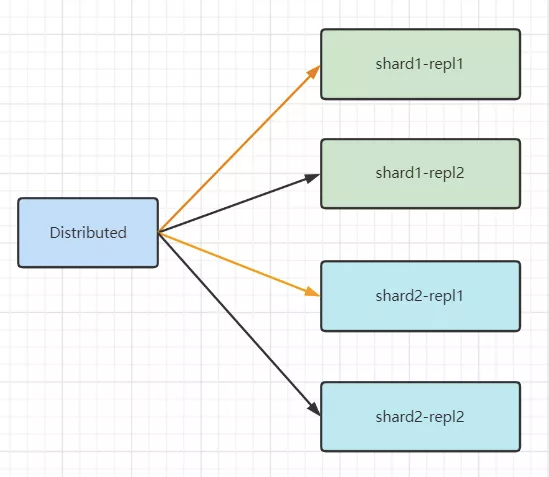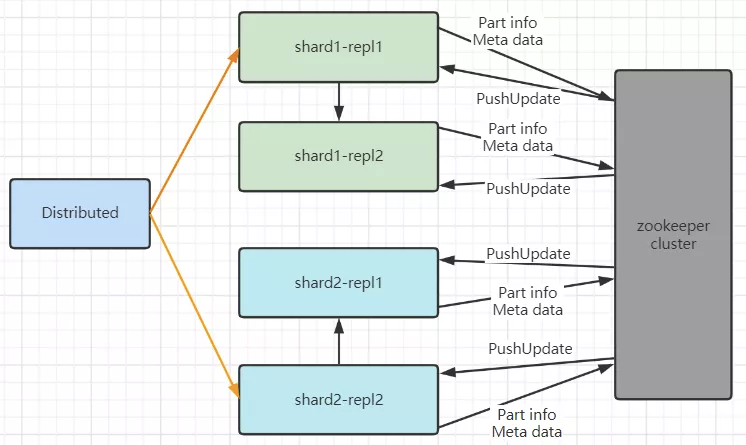作者:吴帆 青云数据库团队成员
主要负责维护 MySQL 及 ClickHouse 产品开发,擅长故障分析,性能优化。
在多副本分布式 ClickHouse 集群中,通常需要使用 Distributed 表写入或读取数据,Distributed 表引擎自身不存储任何数据,它能够作为分布式表的一层透明代理,在集群内部自动开展数据的写入、分发、查询、路由等工作。
Distributed 表实现副本数据同步有两种方案:
| Distributed + MergeTree
在使用这种方案时 internal_replication 需要设为 false,向 Distributed 表写入数据,Distributed 表会将数据写入集群内的每个副本。Distributed 节点需要负责所有分片和副本的数据写入工作。

1. 集群配置
<logical_consistency_cluster>
<shard>
<internal_replication>false</internal_replication>
<replica>
<host>shard1-repl1</host>
<port>9000</port>
</replica>
<replica>
<host>shard1-repl2</host>
<port>9000</port>
</replica>
</shard>
</logical_consistency_cluster>
2. 数据写入
CREATE TABLE test.t_local on cluster logical_consistency_cluster
(
EventDate DateTime,
CounterID UInt32,
UserID UInt32
) ENGINE MergeTree() PARTITION BY toYYYYMM(EventDate) ORDER BY (CounterID, EventDate) ;
CREATE TABLE test.t_logical_Distributed on cluster logical_consistency_cluster
(
EventDate DateTime,
CounterID UInt32,
UserID UInt32
)
ENGINE = Distributed(logical_consistency_cluster, test, t_local, CounterID) ;
INSERT INTO test.t_logical_Distributed VALUES (\'2019-01-16 00:00:00\', 1, 1),(\'2019-02-10 00:00:00\',2, 2),(\'2019-03-10 00:00:00\',3, 3)
3. 数据查询
# shard1-repl1
SELECT *
FROM test.t_local
Query id: bd031554-b1e0-4fda-9ff8-1145ffae5b02
┌───────────EventDate──┬─CounterID─┬─UserID─┐
│ 2019-03-10 00:00:00 │ 3 │ 3 │
└─────────────────────┴───────────┴────────┘
┌───────────EventDate─┬─CounterID─┬─UserID─┐
│ 2019-02-10 00:00:00 │ 2 │ 2 │
└─────────────────────┴───────────┴────────┘
┌───────────EventDate─┬─CounterID─┬─UserID─┐
│ 2019-01-16 00:00:00 │ 1 │ 1 │
└─────────────────────┴───────────┴────────┘
3 rows in set. Elapsed: 0.004 sec.
------------------------------------------
# shard1-repl2
SELECT *
FROM test.t_local
Query id: 636f7580-02e0-4279-bc9b-1f153c0473dc
┌───────────EventDate─┬─CounterID─┬─UserID─┐
│ 2019-01-16 00:00:00 │ 1 │ 1 │
└─────────────────────┴───────────┴────────┘
┌───────────EventDate─┬─CounterID─┬─UserID─┐
│ 2019-03-10 00:00:00 │ 3 │ 3 │
└─────────────────────┴───────────┴────────┘
┌───────────EventDate─┬─CounterID─┬─UserID─┐
│ 2019-02-10 00:00:00 │ 2 │ 2 │
└─────────────────────┴───────────┴────────┘
3 rows in set. Elapsed: 0.005 sec.
通过写入测试我们可以看到每个副本数据是一致的。
即使本地表不使用 ReplicatedMergeTree 表引擎,也能实现数据副本的功能。但每个副本的数据是通过 Distributed 表独立写入,文件存储格式不会完全一致,可以理解这种方式为逻辑一致性。
Distributed 需要同时负责分片和副本的数据写入工作,单点写入很有可能会成为系统性能的瓶颈,所有有接下来的第二种方案。
| Distributed + ReplicateMergeTree
在使用这种方案时 internal_replication 需要设为 true,向 Distributed 表写入数据。Distributed 表在每个分片中选择一个合适的副本并对其写入数据。
分片内多个副本之间的数据复制会由 ReplicatedMergeTree 自己处理,不再由 Distributed 负责。

1. 配置文件
<physical_consistency_cluster>
<shard>
<internal_replication>true</internal_replication>
<replica>
<host>shard1-repl1</host>
<port>9000</port>
</replica>
<replica>
<host>shard1-repl2</host>
<port>9000</port>
</replica>
</shard>
</physical_consistency_cluster>
2. 数据写入
CREATE TABLE test.t_local on cluster physical_consistency_cluster
(
EventDate DateTime,
CounterID UInt32,
UserID UInt32
)
ENGINE = ReplicatedMergeTree(\'{namespace}/test/t_local\', \'{replica}\')
PARTITION BY toYYYYMM(EventDate)
ORDER BY (CounterID, EventDate, intHash32(UserID))
SAMPLE BY intHash32(UserID);
CREATE TABLE test.t_physical_Distributed on cluster physical_consistency_cluster
(
EventDate DateTime,
CounterID UInt32,
UserID UInt32
)
ENGINE = Distributed(physical_consistency_cluster, test, t_local, CounterID);
INSERT INTO test.t_physical_Distributed VALUES (\'2019-01-16 00:00:00\', 1, 1),(\'2019-02-10 00:00:00\',2, 2),(\'2019-03-10 00:00:00\',3, 3)
3. 数据查询
# shard1-repl1
SELECT *
FROM test.t_local
Query id: d2bafd2d-d0a8-41b4-8d79-ece37e8159e5
┌───────────EventDate──┬─CounterID─┬─UserID─┐
│ 2019-03-10 00:00:00 │ 3 │ 3 │
└─────────────────────┴───────────┴────────┘
┌───────────EventDate─┬─CounterID─┬─UserID─┐
│ 2019-02-10 00:00:00 │ 2 │ 2 │
└─────────────────────┴───────────┴────────┘
┌───────────EventDate─┬─CounterID─┬─UserID─┐
│ 2019-01-16 00:00:00 │ 1 │ 1 │
└─────────────────────┴───────────┴────────┘
3 rows in set. Elapsed: 0.004 sec.
------------------------------------------
# shard1-repl2
SELECT *
FROM test.t_local
Query id: b5f0dc80-f73f-427e-b04e-e5b787876462
┌───────────EventDate─┬─CounterID─┬─UserID─┐
│ 2019-01-16 00:00:00 │ 1 │ 1 │
└─────────────────────┴───────────┴────────┘
┌───────────EventDate─┬─CounterID─┬─UserID─┐
│ 2019-03-10 00:00:00 │ 3 │ 3 │
└─────────────────────┴───────────┴────────┘
┌───────────EventDate─┬─CounterID─┬─UserID─┐
│ 2019-02-10 00:00:00 │ 2 │ 2 │
└─────────────────────┴───────────┴────────┘
3 rows in set. Elapsed: 0.005 sec.
ReplicatedMergeTree 需要依靠 ZooKeeper 的事件监听机制以实现各个副本之间的协同,副本协同的核心流程主要有:INSERT、MERGE、MUTATION 和 ALTER 四种。
通过写入测试我们可以看到每个副本数据也是一致的,副本之间依靠 ZooKeeper 同步元数据,保证文件存储格式完全一致,可以理解这种方式是物理一致。
ReplicatedMergeTree 也是在分布式集群中最常用的一种方案,但数据同步需要依赖 ZooKeeper,在一些 DDL 比较频繁的业务中 Zookeeper 往往会成为系统性能的瓶颈,甚至会导致服务不可用。
我们需要考虑为 ZooKeeper 减负,使用第一种方案 + 负载均衡轮询的方式可以降低单节点写入的压力。
总结
- internal_replication = false
使用 Distributed + MergeTree 可实现逻辑一致分布式。
数据内容完全一致,数据存储格式不完全一致,数据同步不依赖 ZooKeeper,副本的数据可能会不一致,单点写入压力较大。
- internal_replication = true
使用 Distributed + ReplicateMergeTree 可实现物理一致分布式。
数据内容完全一致,数据存储格式完全一致。数据同步需要依赖 ZooKeeper,ZooKeeper 会成为系统瓶颈。
来源:https://www.cnblogs.com/radondb/p/15324859.html
图文来源于网络,如有侵权请联系删除。
 百木园
百木园